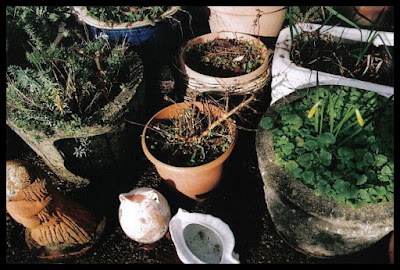Someone
once told me that Beer was nicknamed 'The Devil's Own Village', although I've only ever heard it from that one person. Even so, I
think it's rather apt that the Archangel who threw Satan out of heaven
should be the patron saint of the parish church! ;)I'd
been meaning to visit the church for some time and the opportunity to
do so came on a cold, windy, rainy Sunday in the middle of January
2011. It was my birthday and I wanted to go out somewhere, but I had
to rely on the restricted Sunday bus service and all my first choices
were shut for the winter season...so Beer it was. A couple of hours here, a
picnic lunch in the shelter of the gardens on the cliff overlooking the village,
then a very wet and blustery walk back home across the cliffs and down into Seaton. What else
could a girl wish for on her birthday! ;)
Lovely blue doors - the left one inside the front porch and the other outside on the right of the building - really stood out brightly on such a grey day.
Although
this specific building was erected in 1877, a previous chapel had
existed on this site since the 16th century and was subsequently demolished to
make way for the present one. It is thought that another, earlier
religious building may have stood here since 1122 AD, when Beer and
Seaton belonged to the Abbey of Sherborne. Deeds show that nearby
vineyards were tended by monks of Sherborne and a 13th century inventory
stated that the village had to provide an annual supply of fish, salt
and a tythe of wine from the vineyard for the Abbey.
It was also reputed to have been used as a safe place to store
contraband by the local smugglers. It's interesting to think that the
famous local smuggler, Jack Rattenbury, may well have attended the
chapel that stood here before this one.
Originally the tower had a spire with lucarnes. I had to look up the word lucarne, as I hadn't come across it before. Basically, it refers to a dormer window - a gabled opening - especially set into a roof. In Britain it's also particularly used for small windows into unoccupied spaces such as attics or spire spaces. Anyway, the spire was eventually demolished and the top part of the tower was built upon as we see it today.
A Grade II Listed Building, consisting mainly of coursed stone and built in the Early English/Decorated style, it's a large church comprising the nave, low north and south aisles with north and south transepts.
The east window in the chancel consists of five lights in the decorated style.
Contemporary furnishings include the choir stalls, stone pulpit (seen above) and font (below).
The
walls and most of the tower consist of Hoole Head blue limestone and
the columns which support the nave arcade are of Devon marble.
The lovely multifoil round windows above the arcade are an absolute delight.
The
photos below show close-ups of the marble topped with beautiful foliate
carvings and a carved head stop where the two arches converge.
Two of the stained glass windows, below; a two-light window from the chancel and the three-light one from the north aisle, also seen below the others.
I don't know why but I've never been very good at taking photos of stained glass windows! Probably because I'm overcompensating the light settings and unable to get a decent focus. I think I'll have to take a film of just windows and experiment until I've got it right, lol.
This is a delightful, friendly church with lots of interesting artefacts. The old clock is displayed amongst a second-hand bookstore shown in the above photo, the workings of which can be seen below.
Also an old street lamp on the windowsill beneath the tower.
Above
the West door, below, is the Washbourne Light. This was the old harbour
light which used to be situated upon the cliffs, used to guide the fishermen back to Beer. Unfortunately, I didn't get a decent close-up of the lamp but you can just about make it out above the entrance at the bottom of the nave, below.
I really enjoyed the time spent here as the atmosphere was very welcoming. The exterior was particularly interesting and I just managed to take several more photos before it started to rain in earnest...
...then off to my wintry picnic, walk across the cliffs and the descent down into Seaton. :)
And finally, the last photo taken on a different, much brighter, day.















































































